Overview
In today’s retail landscape, many businesses struggle to engage customers effectively. This challenge can lead to frustration for both retailers and consumers, as shoppers often find it difficult to visualize how products will fit into their lives. Imagine walking into a store, feeling overwhelmed by choices, and leaving without making a purchase. It’s a common scenario that leaves both parties feeling unsatisfied.
But there’s hope. Augmented reality (AR) is transforming retail strategies by creating immersive experiences that allow consumers to visualize products in their own environments. This technology not only enhances customer engagement but also supports decision-making, making shopping a more enjoyable experience. For instance, IKEA’s AR app lets customers see how furniture would look in their homes, while Warby Parker’s virtual try-on feature allows users to see how glasses fit their faces. These innovations boost consumer confidence and satisfaction, fostering loyalty and improving operational efficiency.
As tech startup founders, you have the opportunity to embrace these advancements. By integrating AR into your retail strategies, you can create a more engaging shopping experience that resonates with your customers. It’s about nurturing relationships and understanding the emotional needs of your audience. Let’s work together to explore how these technologies can not only enhance your business but also create a supportive community around your brand. Your journey towards a more connected retail experience starts here.
Introduction
In today’s fast-paced retail world, many brands find themselves struggling to create genuine connections with their customers. This disconnect often leads to frustrating shopping experiences that leave consumers feeling unheard and unsatisfied. Imagine walking into a store, hoping for a seamless experience, only to be met with confusion and disappointment. It’s a scenario that many of us can relate to, and it highlights a significant challenge for retailers.
As brands strive to meet the evolving expectations of today’s discerning shoppers, the implications of these challenges become clear. Consumers are not just looking for products; they crave engaging and interactive experiences that resonate with their needs and desires. This is where augmented reality (AR) pricing steps in as a powerful solution. By offering immersive, interactive experiences, AR has the potential to transform the way retailers engage with their customers, fostering deeper connections and enhancing overall satisfaction.
However, embracing this innovative technology isn’t without its complexities. Retailers must navigate the intricate landscape of consumer expectations and market dynamics. How can AR reshape pricing strategies to not only meet but exceed the demands of today’s shoppers? The answer lies in understanding the emotional needs of consumers and leveraging technology to create meaningful interactions. At RNO1, we believe that by harnessing the power of AR, retailers can not only address these challenges but also build lasting relationships with their customers, ultimately leading to a more fulfilling shopping experience.
RNO1: Revolutionizing Retail Pricing with Augmented Reality Solutions
In today’s retail landscape, many brands struggle to connect meaningfully with their customers. This disconnect can lead to frustrating shopping experiences, where consumers feel overwhelmed and uncertain about their choices. It’s a challenge that weighs heavily on both retailers and shoppers alike, as the emotional toll of indecision can dampen the joy of shopping.
At RNO1, we understand these pain points deeply. We believe that shopping should be an enjoyable journey, not a stressful task. That’s why we’re committed to transforming retail cost strategies through the innovative use of augmented reality pricing. By harnessing AR technology, we empower retailers to create immersive environments where shoppers can visualize products in real-time. Imagine being able to see how a piece of furniture fits in your living room or how a pair of glasses looks on your face before making a purchase. This capability not only enhances decision-making but also fosters a sense of confidence and satisfaction in consumers.
Engaging with products in such a dynamic way cultivates stronger relationships between brands and consumers. It’s about more than just transactions; it’s about building trust and loyalty in a competitive environment. Studies reveal that 61% of consumers prefer shopping at retailers that offer augmented reality pricing, highlighting the technology's potential to enhance engagement and loyalty.
Successful implementations, like Warby Parker's virtual try-on feature and IKEA's AR-powered design consultations, showcase how augmented reality pricing can significantly elevate user interactions and satisfaction. These examples remind us that technology can bridge the gap between brands and consumers, creating a more personalized shopping experience.
As the retail sector continues to evolve, RNO1 stands ready to support brands in this journey. Our commitment to leveraging AR technology ensures that we’re not just focused on results; we’re dedicated to delivering real, meaningful experiences that resonate with shoppers. Together, we can shape the future of retail cost strategies, fostering connections that matter.

Virtual Try-Ons: Enhancing Customer Engagement and Pricing Accuracy
Have you ever hesitated before making an online purchase, unsure of how a product might look on you or in your space? This common concern can lead to frustration and second-guessing, making the online shopping experience less enjoyable. The uncertainty often leaves shoppers feeling anxious, which can dampen their excitement about new purchases.
But what if there was a way to alleviate that worry? Enter virtual try-ons. This innovative technology allows individuals to visualize how products will appear on them or in their surroundings before they hit that buy button. By providing a clearer picture, virtual try-ons significantly boost consumer engagement and enhance augmented reality pricing, easing the doubts that often accompany online shopping.
Retailers embracing this technology have seen remarkable results. For instance, Warby Parker has successfully implemented virtual try-on solutions, enabling customers to 'try on' eyewear digitally. This not only leads to increased sales but also fosters greater customer satisfaction. Similarly, Sephora's virtual try-on technology allows users to experiment with makeup products in real-time, creating a more interactive and engaging shopping environment that builds loyalty.
As Amy O’Brien, tech editor at Vogue Business, points out, advancements in virtual try-on technology are reshaping the online shopping landscape. It’s becoming essential for brands to adapt to these changes, ensuring they meet evolving consumer expectations. However, as fashion brands explore AI campaigns, they must navigate potential pitfalls, aligning their strategies with what today’s consumers truly want.
These case studies highlight the transformative potential of virtual try-ons in modern retail strategies. By incorporating such technologies into their cost models, brands can significantly improve overall client satisfaction. So, if you’re a tech startup founder looking to enhance your customer experience, consider how virtual try-ons can be a nurturing solution to the challenges your audience faces.
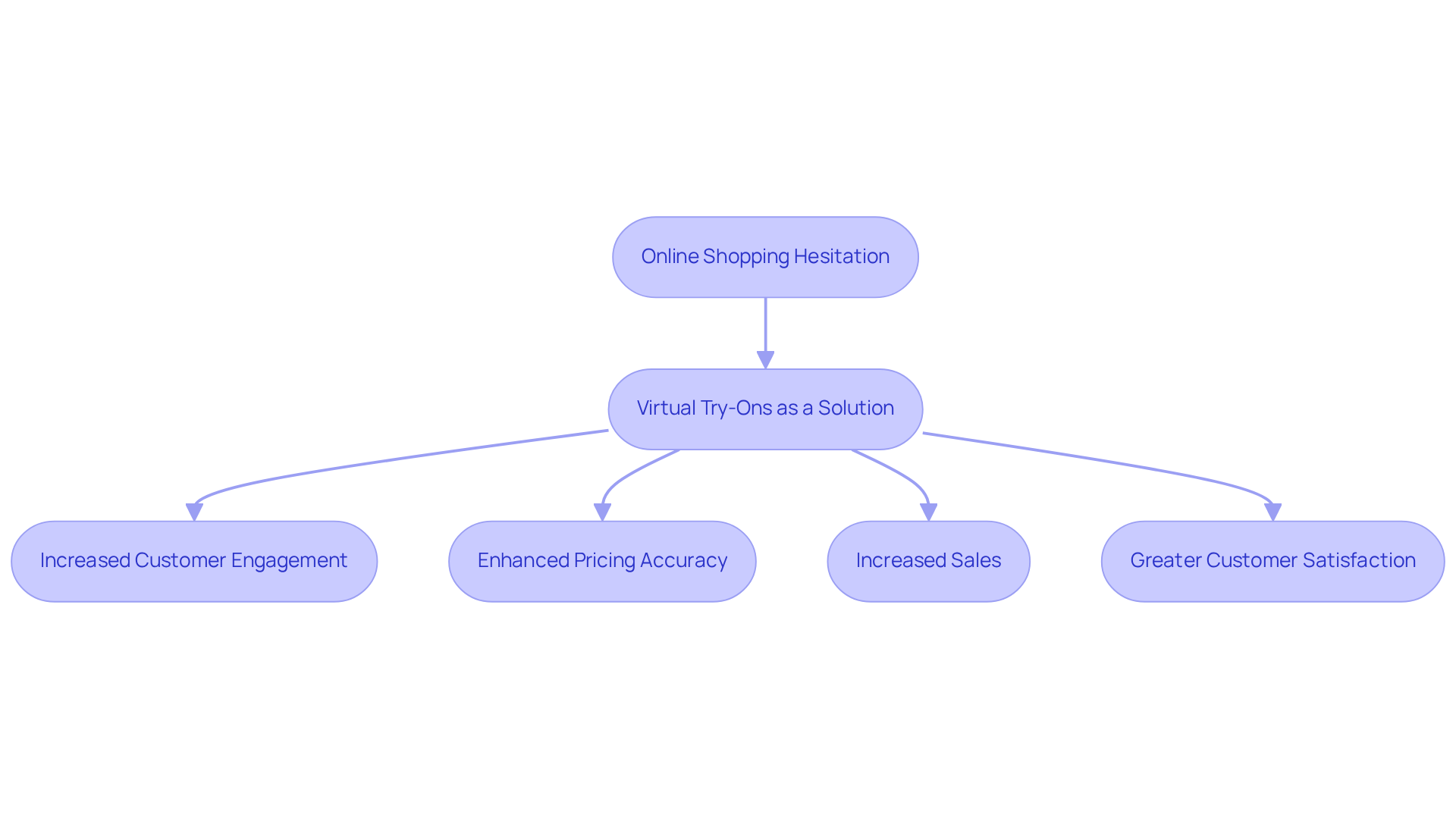
Home Furnishing Visualization: Transforming Pricing Perceptions in Retail
Buying furniture can often feel overwhelming, can’t it? Many of us have experienced that moment of doubt when we wonder if a piece will truly fit in our space or match our style. This uncertainty can lead to anxiety about spending money on something that might not work out, and it’s a pain point that many consumers face.
Imagine standing in a store, looking at a beautiful sofa, but feeling unsure if it will look right in your living room. This hesitation can lead to second-guessing and, ultimately, a decision to walk away. It’s frustrating, and it can even result in returns, which nobody enjoys.
But here’s where augmented reality pricing steps in as a comforting solution. Take IKEA’s AR application, for example. It allows users to visualize how furniture will look in their own homes, right from their smartphones. By positioning virtual pieces in their spaces, consumers can make informed choices that feel right for them. This not only boosts their confidence but also aligns the value they perceive with the augmented reality pricing.
When shoppers can see how a piece fits into their lives, it transforms the experience from one of anxiety to one of excitement. They can feel assured that they’re making the right choice, which is incredibly empowering. So, if you’re a tech startup founder looking to enhance your customer’s journey, consider how you can incorporate similar solutions. Let’s create a shopping experience that nurtures confidence and connection, making every purchase a joyful one.
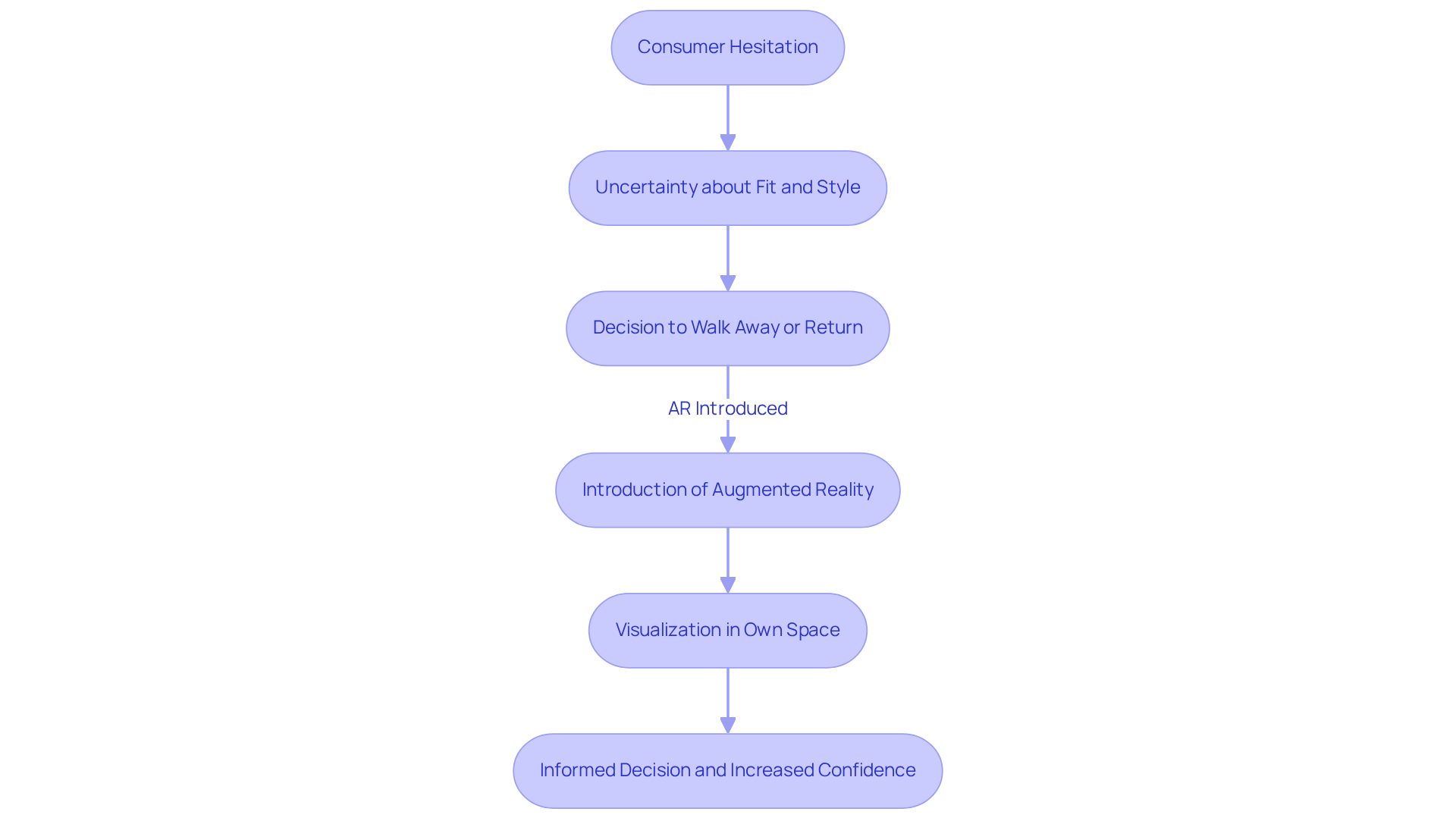
Operational Efficiency: How AR Streamlines Retail Pricing Strategies
In today’s fast-paced retail environment, many businesses face the daunting challenge of managing fluctuating costs. It can be overwhelming to keep up with inventory levels, customer demand, and competitor pricing. This constant pressure can lead to stress and uncertainty, making it difficult for retailers to maintain a competitive edge.
Imagine a scenario where you’re trying to adjust prices manually, only to find that by the time you’ve made changes, the market has shifted again. This not only consumes valuable time but can also impact your profitability. The emotional toll of this struggle is real, and it’s something many in the retail sector can relate to.
But there’s hope. Augmented reality (AR) offers a transformative solution that can ease this burden. By automating pricing processes and leveraging real-time data analytics, retailers can use augmented reality pricing to swiftly adjust prices in response to market changes. This means you can enhance your strategies without the stress of manual modifications.
Consider the benefits:
- Dynamic cost models that adapt instantly to market fluctuations can significantly improve operational efficiency.
- Retailers can save time and increase profitability by aligning their rates with actual market conditions.
- In fact, studies show that dynamic cost adjustments can enhance brand value by 20% and reduce inventory holding costs by 9.6%.
However, it’s essential to approach these changes with care. While dynamic pricing can boost performance, it may also affect how customers perceive your brand and their loyalty to it. Balancing these adjustments with a focus on quality and customer relationships is crucial for long-term success.
At RNO1, we understand the challenges you face, and we’re here to support you in navigating these complexities. Together, we can explore how augmented reality pricing can not only streamline your strategies but also foster deeper connections with your customers.

Future Trends: The Next Generation of AR Pricing in Retail
The future of augmented reality (AR) in retail is on the brink of remarkable transformations, and it’s essential to recognize the challenges that come with it. As technology advances, retailers face the pressing need to adapt to individual consumer behaviors. This can feel overwhelming, especially when trying to enhance customer engagement while also gaining insights into price sensitivity and preferences. It’s a lot to juggle, and many retailers may feel uncertain about how to navigate these changes.
Statistics reveal that the integration of AI and machine learning in AR for retail is gaining momentum, with projections indicating a significant increase in adoption rates in the coming years. For instance, a recent study highlighted that by 2030, 50% of all service requests in retail could be initiated by AI-driven systems. This shift underscores a growing reliance on intelligent technologies, which can be both exciting and daunting for those in the industry.
Consider the case of AVA, a cutting-edge platform that has effectively incorporated AI and augmented reality pricing to enhance product discovery and cost strategies. By allowing users to virtually 'Try-On' products, AVA not only enhances the shopping experience but also provides retailers with real-time data on consumer preferences. This dynamic approach enables retailers to adjust costs in response to actual consumer behavior, alleviating some of the pressure they face.
Experts forecast that the integration of AR with AI will significantly transform strategies related to augmented reality pricing in retail. As brands progressively embrace these technologies, we can anticipate a shift towards more flexible and responsive cost structures, including augmented reality pricing, that truly address the evolving needs of consumers. It’s a journey, and while it may seem challenging, there’s a supportive community ready to help navigate these changes. At RNO1, we understand the emotional and professional needs of tech startup founders, and we’re here to guide you through this exciting transformation.
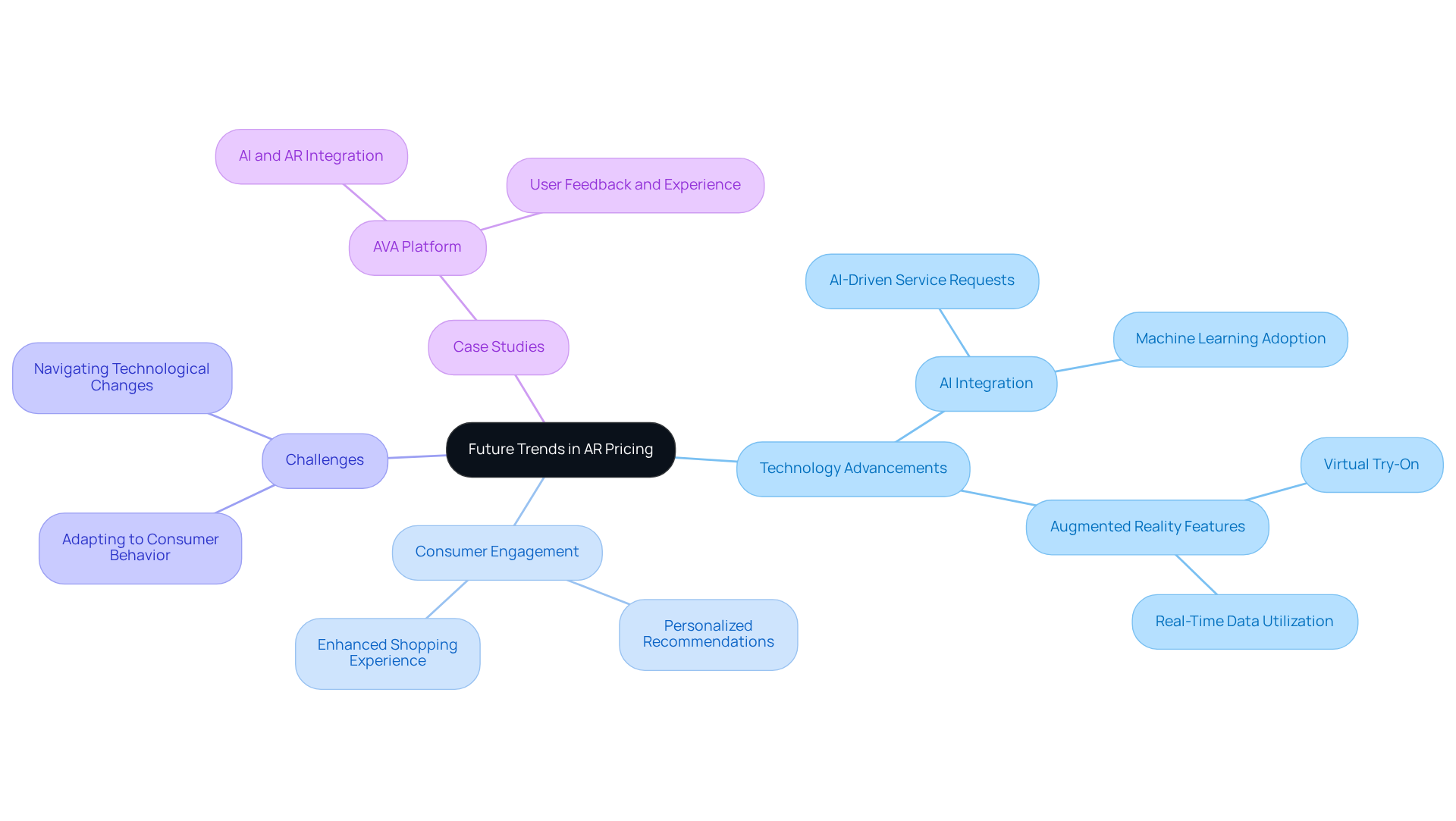
Fundamentals of Augmented Reality in Retail Pricing
Augmented reality (AR) in retail sales has the potential to truly transform the shopping experience, but it also brings to light some challenges that many consumers face. Imagine walking into a store, excited to explore, only to find that the technology meant to enhance your experience isn’t accessible to everyone. Not all shoppers have AR-enabled devices or the familiarity with this innovative technology, which can leave them feeling left out. This gap can be frustrating, especially when augmented reality pricing has so much to offer, including real-time pricing updates, promotional offers, and product comparisons that empower consumers to make informed decisions.
As a specialist at Launch wisely pointed out, "AR is no longer a novelty; it’s a competitive advantage." This highlights the importance of brands stepping up to bridge this gap. Statistics reveal that AR solutions can significantly decrease return rates, which not only helps reduce operational expenses but also fosters long-term client loyalty. However, it’s crucial for brands to recognize the emotional impact of accessibility. By adopting AR thoughtfully, they can meet and even exceed consumer expectations, creating memorable moments that resonate with shoppers.
For retailers aiming to utilize AR effectively, understanding these fundamentals is essential. It’s about more than just technology; it’s about nurturing a connection with consumers and ensuring that everyone can benefit from these advancements. Together, we can create a shopping environment that is inclusive and empowering for all.

Customer Experience Impact: AR's Role in Shaping Pricing Strategies
In today’s retail landscape, many businesses struggle with user engagement, which can leave customers feeling disconnected and unsatisfied. This lack of interaction not only diminishes client satisfaction but can also hinder loyalty, making it harder for retailers to encourage consumers to invest in their products. Imagine walking into a store where everything feels flat and uninspiring—it's easy to see why shoppers might hesitate to make a purchase.
But there’s hope. Augmented reality (AR) offers a nurturing solution that transforms these retail environments into immersive and interactive experiences. By leveraging AR, retailers can create spaces that invite customers to engage deeply with products, fostering a sense of connection and satisfaction. In fact, a NielsenIQ survey reveals that 61% of consumers prefer shopping at retailers that offer AR experiences. This statistic highlights the powerful link between enhanced user experience and successful pricing strategies.
Consider IKEA, for example. Their use of AR for virtual design consultations allows customers to visualize products in their own spaces, boosting confidence in their purchasing decisions and significantly reducing return rates. This capability shines particularly in sectors like fashion and home furnishings, where virtual try-ons and design consultations lead to greater client satisfaction and loyalty.
As retailers embrace augmented reality pricing, they can thoughtfully adjust their value models to reflect the additional benefits this technology brings to the purchasing experience. By nurturing these connections, businesses not only enhance customer satisfaction but also cultivate lasting loyalty, encouraging consumers to invest more in their products. Together, we can create a retail environment that truly resonates with the needs and desires of today’s shoppers.

Personalized Pricing: Leveraging AR for Tailored Customer Experiences
Augmented reality pricing offers a wonderful opportunity for retailers to connect with their customers on a deeper level by tailoring cost strategies based on individual preferences. Imagine a shopper who loves eco-friendly products; with AR technology, brands can send them exclusive discounts on sustainable items right when they need them. This kind of personalization not only makes shopping more enjoyable but also builds a sense of loyalty and trust between the customer and the brand.
However, many retailers struggle to engage their customers effectively. It can be disheartening to see potential buyers walk away, especially when studies reveal that 61% of consumers prefer stores that offer AR interactions. Even more compelling, 71% would likely shop more frequently if AR were available. This highlights a significant gap that retailers need to address to enhance consumer engagement.
The beauty of AR lies in its ability to create immersive product experiences that are 200% more engaging than traditional methods. Picture this: a customer can visualize products in their own space, bridging the gap between online and offline shopping. As retailers embrace AR, they not only stand out in a crowded market but also foster greater satisfaction and drive revenue.
Take Marks & Spencer's List&Go application, for instance. It’s a fantastic example of how AR can simplify the shopping experience by guiding customers through stores based on their lists. This thoughtful approach not only helps reduce return rates but also empowers shoppers to make informed choices. By integrating AR into their strategies, retailers can truly enhance the shopping journey, creating a nurturing environment that resonates with their customers.
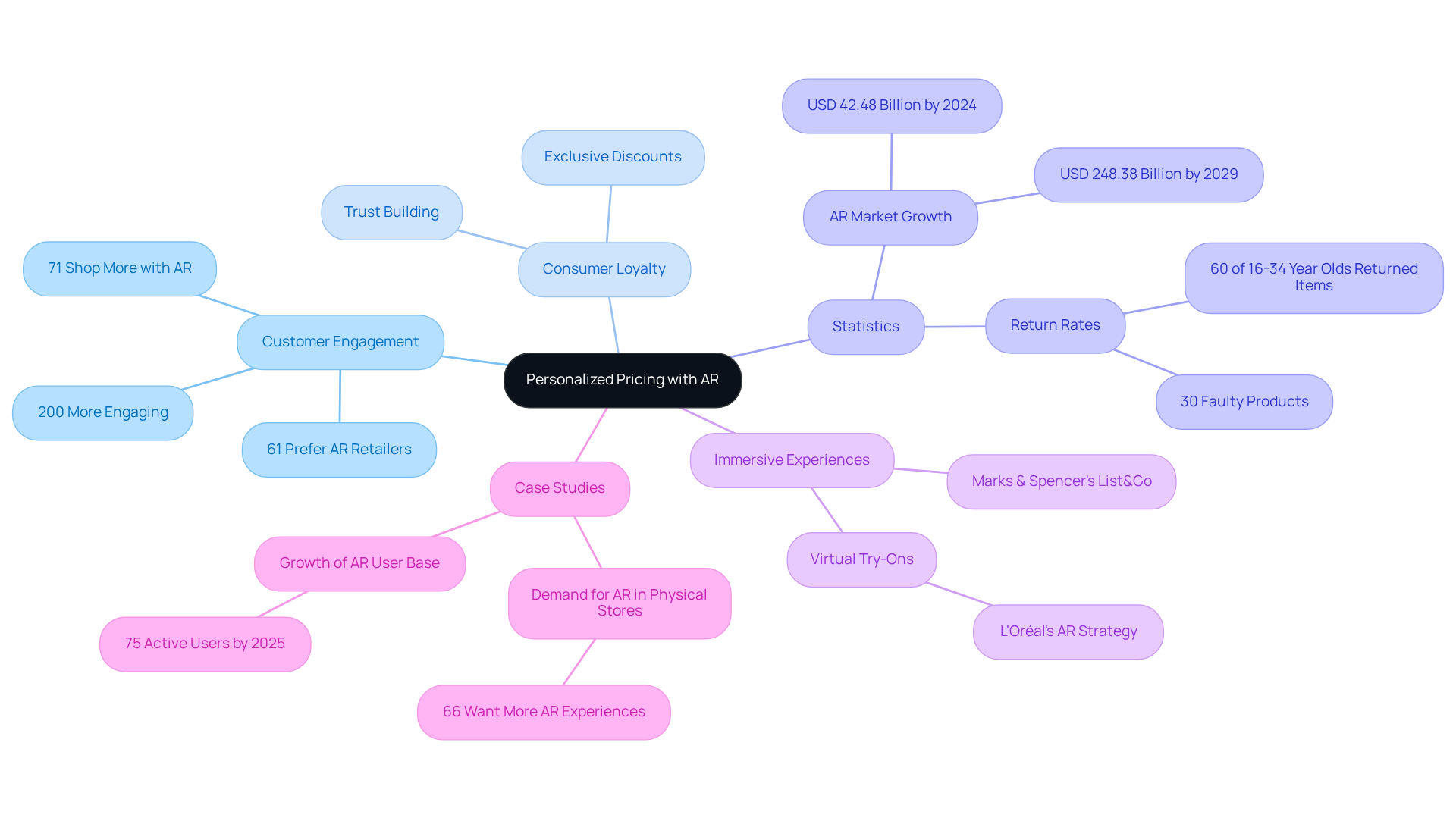
Interactive Pricing Displays: Engaging Customers with Augmented Reality
Shopping can often feel overwhelming, can’t it? With so many choices and fluctuating prices, it’s easy to feel lost. Many consumers struggle to find the best deals and understand product information, which can lead to frustration and confusion.
Imagine walking into a store where the prices and promotions come to life right before your eyes. Interactive cost displays utilizing augmented reality pricing can transform your shopping experience into something truly captivating. These displays don’t just show static prices; they dynamically adjust based on your interactions, inventory levels, and augmented reality pricing. Imagine augmented reality pricing with virtual price tags that change as you explore different products, making it easier to find what you need without the stress.
This innovative approach not only enhances your shopping journey but also provides retailers with valuable insights into your preferences and behaviors. By understanding what you’re looking for, they can refine their strategies to better meet your needs. It’s a win-win situation!
At RNO1, we believe in creating solutions that nurture both consumers and retailers. By embracing augmented reality, we can help make shopping a more enjoyable and informed experience for everyone. Let’s work together to bring this vision to life!
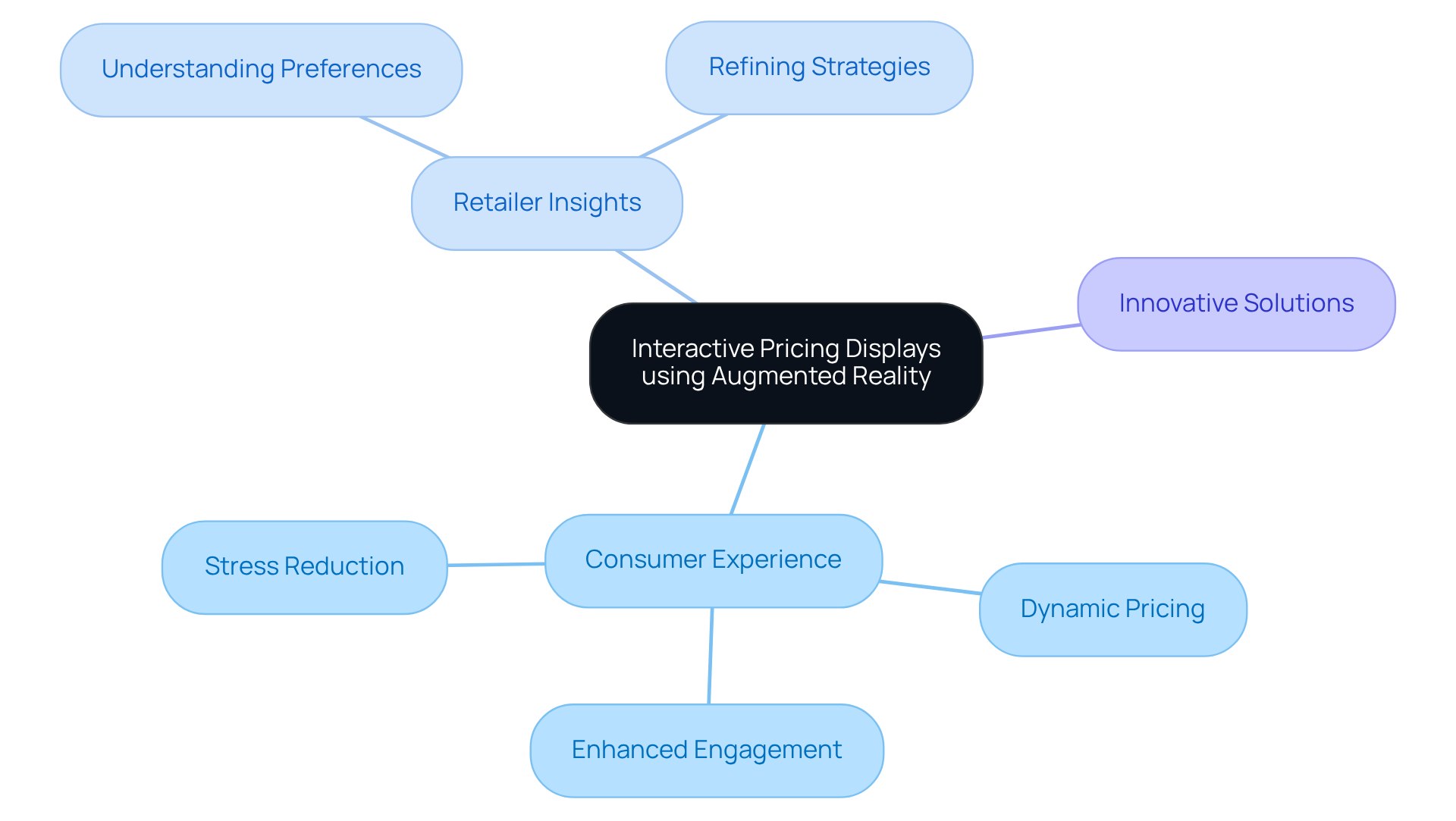
Competitive Edge: The Necessity of AR in Modern Retail Pricing Strategies
In today’s fiercely competitive retail landscape, the integration of augmented reality (AR) has shifted from being a luxury to an essential tool for success. Retailers who embrace augmented reality pricing in their pricing strategies can create unique and captivating purchasing experiences that truly set them apart from their competitors. This competitive edge is becoming increasingly vital as consumers seek personalized and interactive shopping options that resonate with their individual needs.
Consider the example of Warby Parker’s virtual try-on app. It not only enhances user engagement but also allows individuals to visualize how glasses will look on their faces, making the decision-making process smoother and more enjoyable. Similarly, IKEA’s Place app empowers users to see how furniture fits in their homes, significantly boosting their confidence in purchases and reducing return rates. Sephora’s Virtual Artist takes this a step further by enabling customers to virtually try on makeup, enhancing convenience and hygiene. Meanwhile, L'Oréal’s AR kiosks allow customers to explore various hairstyles and colors before making a commitment.
As consumer expectations continue to evolve, brands that overlook the importance of AR risk falling behind. It’s concerning to note that 61% of consumers prefer brands that offer AR interactions, underscoring the growing demand for creative personalization in shopping experiences. Moreover, Shopify reports that products featuring AR experiences can boost conversion rates by up to 94%. By integrating augmented reality pricing into their pricing strategies, retailers not only enhance customer convenience but also align with modern consumer preferences, ensuring they remain relevant and successful in an ever-changing market.
To stay ahead in this dynamic environment, retailers should consider implementing AR solutions tailored to their specific audience. This approach not only enhances engagement but also drives sales, fostering a deeper connection with customers. Embracing AR is not just about keeping up; it’s about nurturing relationships and creating memorable experiences that resonate with today’s consumers.
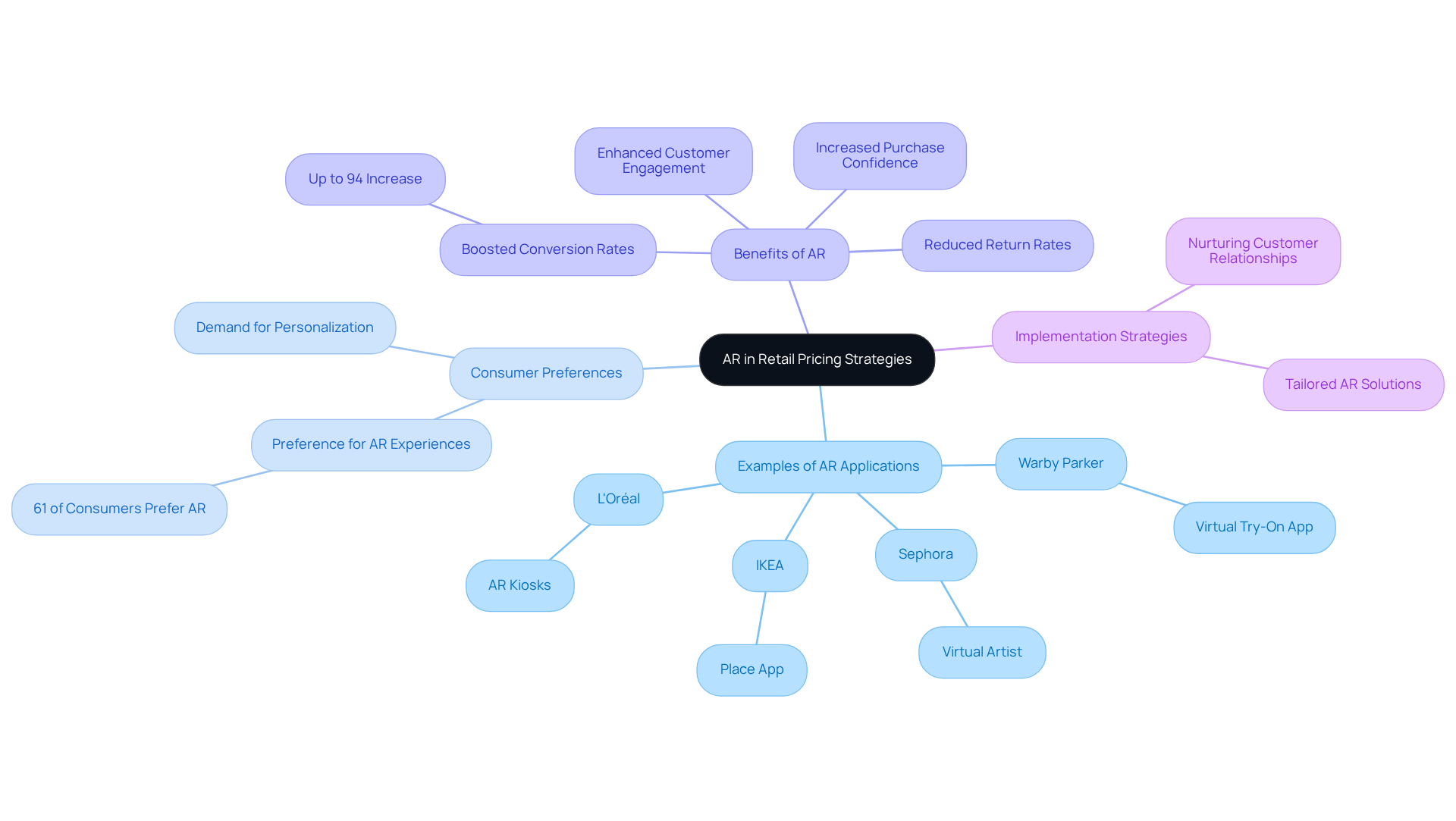
Conclusion
Augmented reality (AR) pricing isn’t just about technology; it’s a heartfelt shift in how retailers connect with their customers and rethink their pricing strategies. Imagine walking into a store and feeling completely confident in your choices, thanks to immersive experiences that AR can provide. This is especially important in today’s fast-paced world, where consumer preferences are constantly changing and evolving.
Think about the challenges retailers face: customers often feel uncertain about their purchases. This uncertainty can lead to frustration and hesitation. But with AR, brands can offer solutions like virtual try-ons and home furnishing visualizations that truly make a difference. Take Warby Parker and IKEA, for example. Their success stories show how AR can ease those worries, leading to happier customers who feel more loyal to the brand.
As we look to the future, embracing augmented reality pricing is essential for brands that want to remain relevant and competitive. The chance to create personalized experiences and foster deeper connections with customers is a unique opportunity. By prioritizing AR solutions, retailers can enhance their pricing strategies and craft memorable shopping experiences that resonate with today’s consumers. This approach not only addresses immediate concerns but also paves the way for long-term success in a dynamic marketplace. Let’s support each other in this journey, ensuring that every shopping experience is not just a transaction, but a meaningful connection.
Frequently Asked Questions
What challenges do consumers face in the retail shopping experience?
Consumers often struggle with feeling overwhelmed and uncertain about their choices, which can lead to frustrating shopping experiences and emotional stress.
How does RNO1 aim to improve the retail shopping experience?
RNO1 aims to improve the shopping experience by transforming retail pricing strategies through augmented reality (AR) technology, allowing consumers to visualize products in real-time and enhancing decision-making.
What are the benefits of using augmented reality pricing in retail?
Augmented reality pricing enhances consumer engagement, fosters confidence in purchasing decisions, and helps build trust and loyalty between brands and consumers.
Can you provide examples of successful augmented reality implementations in retail?
Successful examples include Warby Parker's virtual try-on feature for eyewear and IKEA's AR-powered design consultations for furniture, both of which significantly enhance user interactions and satisfaction.
How do virtual try-ons enhance customer engagement?
Virtual try-ons allow consumers to visualize how products will look on them or in their space, alleviating uncertainty and boosting engagement, which leads to increased sales and customer satisfaction.
What impact has virtual try-on technology had on retailers?
Retailers like Warby Parker and Sephora have seen remarkable results from implementing virtual try-on technology, leading to increased sales and a more interactive shopping environment.
What is the role of home furnishing visualization in the retail experience?
Home furnishing visualization, such as IKEA's AR application, helps consumers see how furniture will look in their homes, reducing anxiety and empowering them to make informed purchasing decisions.
How does augmented reality pricing transform consumer perceptions of value?
By allowing shoppers to visualize products in their own spaces, augmented reality pricing aligns the perceived value with the product, transforming the shopping experience from anxiety to excitement.




